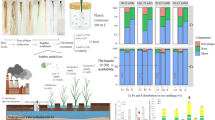Abstract
Zea mays was grown in nutrient solution with different concentrations of sulphite and sulphate (0, 5, and 10 mM) at pH 5 or 7, with or without aeration, for five days. Sulphite injured the plants, especially at low pH. Lack of aeration increased the sulphite injury of the plants at the high pH. in the aerated solutions, sulphite concentrations approached zero after five hours, while the unaerated solutions still contained sulphite after four days. Very little sulphite was found in the plants. The results indicate that the toxicity to the plants of the different chemical species of the sulphite in the solution decreases in the following order: SO2 (aq) > HSO3 − > SO3 2−.
Similar content being viewed by others
References
Babich, H. & Stotzky, G. 1978. Influence of pH on inhibition of bacteria, fungi, and coliphages by bisulfite and sulfite.Environmental Research 15, 405–417.
Beilke, S. & Gravenhorst, G. 1978. Heterogeneous SO2-oxidation in the droplet phase.Atmospheric Environment 12, 231–239.
Donely, J. 1981. Disposal and utilization of spray dryer FDG endproducts, Niro Atomizer. Presented at the Canadian Electrical Assoc. Seminar on SO2 removal by dry processes, Ottawa, Canada, October 1981.
Ferguson, P. & Lee, J. A. 1979. The effects of bisulphite and sulphate upon photosynthesis in sphagnum.New Phytologist 82, 703–712.
Garsed, S.G. 1981. The use of sulphite solutions for studying the effects of SO2 on higher plants.Environmental Pollution (Series A) 24, 303–311.
Gissel-Nielsen, G. 1979. Uptake and translocation of75Se in Zea Mays — International Symp. on the Use of Isotopes and Radiation in Research on Soil-Plant Relationships, 11–15 December 1978, Colombo, Sri Lanka. IAEA-SM-235/8 Vienna 1979.
Harcourt, S.A. & Farrar, J.F. 1980. Some effects of simulated acid rain on the growth of barley and radish.Environmental Pollution (Series A) 22, 69–73.
Hocking, D. & Hocking, M.B. 1977. Equilibrium solubility of trace atmospheric sulphur dioxide in water and its bearing on air pollution injury to plants.Environmental Pollution 13, 57–64.
Linek, V. & Vacek, V. 1981. Chemical engineering use of catalyzed sulfite oxidation kinetics for determination of mass transfer characteristics of gas-liquid contactors.Chemical Engineering Science 36, 1747–1768.
Miller, J.E. & Xerikos, P.B. 1979. Residence time of sulphite in SO2 sensitive and tolerant soybean cultivars.Environmental Pollution 18, 259–264.
Rehm, H.-J. & Wittmann, H. 1962. Beitrag zur Kenntnis der anti-mikrobiellen Wirkung der schwefligen Säure.Zeitschrift für Lebensmitteluntersuchung und -forschung 118, 413–429.
Silvius, J.E., Ingle, M. & Baer, C.H. 1975. Sulfur dioxide inhibition of photosynthesis in isolated spinach chloroplasts.Plant Physiology 56, 434–437.
Takemoto, B.K. & Noble, R.D. 1986. Differential sensitivity of duckweeds (Lemnaceae) to sulphite. I. Carbon assimilation and frond replication rate as factors influencing sulphite phytotoxicity under low and high irradiance.New Phytologist 103, 525–539.
Takemoto, B.K., Noble, R.D. & Harrington, H.M. 1986. Differential sensitivity of duckweeds (Lemnaceae) to sulphite. II. Thiol production and hydrogen sulphide emission as factors influencing sulphite phytotoxicity under low and high irradiance.New Phytologist 103, 541–548.
Tanaka, H., Takanashi, T. & Yatazawa, M. 1974. Experimental studies on SO2 injuries in higher plants. III. Inhibitory effect of sulfite ion on14CO2, fixation.Water, Air, and Soil Pollution 3, 11–16.
Wellburn, A.R. 1985. Ion Chromatographie determination of levels of anions in plastids from fumigated and non-fumigated barley seedlings.New Phytologist 100, 329–339.
West, P.W. & Gaeke, G.C. 1956. Fixation of sulfur dioxide as disulfitomercurate (II) and subsequent colorimetric estimation.Analytical Chemistry 28, 1816–1823.
Wodzinski, R.S., Labeda, D.P. & Alexander, M. 1978. Effects of low concentrations of bisulfite-sulfite and nitrite on micro-organisms.Applied and Environmental Microbiology 35, 718–723.
Author information
Authors and Affiliations
Rights and permissions
About this article
Cite this article
Bertelsen, F., Gissel-Nielsen, G. Toxicity of root-applied sulphite in Zea mays. Environ Geochem Health 9, 12–16 (1987). https://doi.org/10.1007/BF01811111
Received:
Accepted:
Issue Date:
DOI: https://doi.org/10.1007/BF01811111




